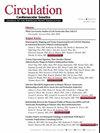Calcific Aortic Valve Disease: Insights Into the Genetics of Vascular Ageing.
引用次数: 2
Abstract
The shifting global demographic profile toward an older population is well recognized and carries with it the increased burden of degenerative cardiovascular disease, with associated morbidity, mortality, and healthcare costs. Vascular ageing is characterized by increased arterial stiffness, systolic arterial hypertension, myocardial thickening and fibrosis, and associated atherosclerosis.1 See Article by Martinsson et al Calcific aortic valve stenosis (CAVS) is another manifestation and affects ≈1 in 30 people aged 75 years. Furthermore, CAVS is associated with several adverse vascular risk factors, including hypertension, hypercholesterolemia, and diabetes mellitus, as well as with underlying structural abnormalities, for example, bicuspid aortic valve. Considerable resources are already devoted to health care consequent on vascular ageing and the load is increasing—as evidenced by the burgeoning need for operative and percutaneous aortic valve replacements.2 If society is to better manage health costs for the older population, we need to better understand the mechanisms of vascular ageing and thereby develop and implement novel preventive strategies. There is significant familial risk for atherosclerotic vascular disease, beyond familial hypercholesterolemia and hypertension, although the actual genetic factors responsible remain elusive. In this issue of Circulation: Cardiovascular Genetics , Martinsson et al3 present evidence for a significant familial risk for CAVS in the general population. At the same time, there is also a lesser, but nonetheless significant, environmental risk. The fascinating question is how we might explain these observations and whether we can now begin to formulate a hypothesis about why some individuals develop CAVS. A systolic ejection murmur is a common finding in older patients and echocardiography has shown us that most individuals develop some thickening and restriction of leaflet motion of the aortic valve with increasing age. Despite this, most …钙化主动脉瓣疾病:血管老化遗传学的见解。
本文章由计算机程序翻译,如有差异,请以英文原文为准。
求助全文
约1分钟内获得全文
求助全文
来源期刊

Circulation: Cardiovascular Genetics
CARDIAC & CARDIOVASCULAR SYSTEMS-GENETICS & HEREDITY
自引率
0.00%
发文量
0
审稿时长
6-12 weeks
期刊介绍:
Circulation: Genomic and Precision Medicine considers all types of original research articles, including studies conducted in human subjects, laboratory animals, in vitro, and in silico. Articles may include investigations of: clinical genetics as applied to the diagnosis and management of monogenic or oligogenic cardiovascular disorders; the molecular basis of complex cardiovascular disorders, including genome-wide association studies, exome and genome sequencing-based association studies, coding variant association studies, genetic linkage studies, epigenomics, transcriptomics, proteomics, metabolomics, and metagenomics; integration of electronic health record data or patient-generated data with any of the aforementioned approaches, including phenome-wide association studies, or with environmental or lifestyle factors; pharmacogenomics; regulation of gene expression; gene therapy and therapeutic genomic editing; systems biology approaches to the diagnosis and management of cardiovascular disorders; novel methods to perform any of the aforementioned studies; and novel applications of precision medicine. Above all, we seek studies with relevance to human cardiovascular biology and disease.
 求助内容:
求助内容: 应助结果提醒方式:
应助结果提醒方式:


